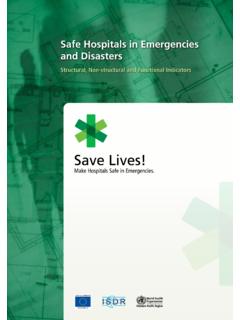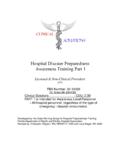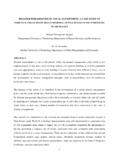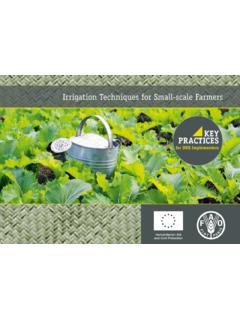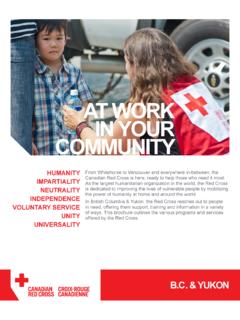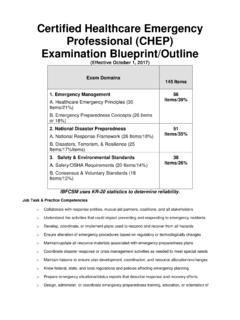Transcription of Safe Hospitals - World Health Organization
1 safe Hospitals Documents available on the web This catalogue in available in electronic format at See also the Hospitals safe from Disasters web site at World Disaster Reduction Campaign The focus of the biennial World Disaster Reduction Campaign (2008-2009) is on Hospitals safe from Disasters: Reduce Risk, Protect Health Facilities, Save Lives . In this global effort, WHO is partnering with the Secretariat of the UN International Strategy for Disaster Reduction (ISDR) and the World Bank to work so that all Health facilities stand up to emergencies and continue to function. Full information kit on the World Disaster Reduction Campaign A safe hospital will not collapse in disasters, killing patients and staff, it can continue to function and provide services as a critical community facility when it is most needed, and it is organized with contingency plans in place and Health workforce trained to keep the network operational.
2 Ensuring that Hospitals and Health facilities are safe from disasters requires strong commitment from the highest political level and support and contribution from all sectors of society. ISDR-Biblio: Health , Disasters and Risk, January 2008 ISDR-Biblio 3 addresses the protection of Health facilities in order to ensure they can function during and in the aftermath of disasters. It also contains additional literature on Health and disaster risk; disaster and emergency management; Health facilities and services; environment, impact on Health ; climate change effects on Health ; mental Health ; mitigation and preparedness; public Health ; water and sanitation; and gender and Health . 10 basic facts to know about safe Hospitals Other materials World Health Day 2009 Campaign World Health Day 2009 focuses on the safety of Health facilities and the readiness of Health workers who treat those affected by emergencies.
3 WHO and international partners are underscoring the importance of investing in Health infrastructure that can withstand hazards and serve people in immediate need. They are also urging Health facilities to implement systems to respond to internal emergencies, such as fires, and ensure the continuity of care. Brochure: World Health Day 2009 Frequently Asked Questions Planning framework: national policy and programme Videos for download Global posters safe Hospitals Documents available on the web This catalogue in available electronic format at 2 WHO Regional Office for the Americas / Pan-American Health Organization World Health Day 2009 kit When disaster strikes, safe Hospitals save lives Posters Promotional brochure Technical brochure Fortune teller / Download Web banners, Sticker Frequently asked questions WHO Regional Office for the Eastern Mediterranean World Health Day 2009 campaign Save lives.
4 Make Hospitals safe in emergencies Campaign Regional strategy Advocacy material Hospitals safe from disasters: a framework for WHO/EMRO s Member States WHO Regional Office for South-East Asia World Health Day 2009 kit Save lives. Make Hospitals safe in emergencies Regional Director s Message on World Health Day Benchmarking for safe Health facilities Basic of safe Hospitals Who can do what for safe Hospitals Are our Health facilities safe ? What questions do we need to ask? Posters, Case studies and Glossary Guidelines and Manuals safe Hospitals : a collective responsibility; a global measure of disaster reduction (PAHO) Protecting critical Health facilities, particularly Hospitals , from the avoidable consequences of disasters is not only essential to meeting the United Nations Millennium Development Goals but also a social and political necessity in its own right. Complete book [7 Mb] Part 1 Part 2 Part 3 Part 4 The hospital Safety Index (PAHO) The hospital Safety Index helps Health facilities assess their safety and avoid becoming a casualty of disasters.
5 It provides a snapshot of the probability that a Health facility will continue to function in emergency situations, based on structural, non-structural and functional factors. By determining a hospital s Safety Index, decision-makers will have an overall idea of its ability to respond to major emergencies and disasters. The Index is made up of three components: Evaluation Forms A Guide for Evaluators Safety Index Calculator (contact safe Hospitals Documents available on the web This catalogue in available electronic format at 3 Guidelines for vulnerability reduction in the design of new Health facilities (PAHO) This publication, produced with the PAHO/WHO Collaborating Center for Disaster Mitigation in Health Facilities at the University of Chile, puts forward three or performance objectives: life safety, investment protection and functional protection. It recommends that essential areas and components of Hospitals be built to keep the third and most demanding performance objective, and that new Health facilities be built entirely so as to meet, at least, the first level of protection, namely life safety.)
6 Complete book Guidelines on non-structural safety in Health facilities (SEARO) These guidelines contain a discussion of the essential role of Health services immediately following a medium or large-scale earthquake, and an outline of the possible threat to lives and functionality of the Health facilities stemming from damage to non-structural components. They also contain a series of illustrated low-cost and easy to implement mitigation measures as part of the day-to-day maintenance of Health facilities. Full book Risk reduction and emergency preparedness: WHO six-year strategy for the Health sector and community capacity development Although major emergencies are often unpredictable, much can be done to prevent and mitigate their effects and to strengthen the response capacity of communities at risk. As the lead agency for addressing the Health aspects of emergency preparedness and response, WHO developed a strategy based on the recommendations of a global consultation held in 2006 to help mitigate the effects of crises, coordinate the response and thus save lives and reduce suffering.
7 Mass casualty management systems During emergencies, experience shows that the community is the first to provide assistance. However, many countries have not yet developed mass casualty management plans, and communities are often left alone to develop preparedness and response plans. Building capacity at the community level to develop such plans requires strong involvement by Health authorities at all levels as well as support from other sectors. In 2006, WHO held a Global Consultation on Mass Casualty Management which produced guidelines designed to help policy-makers, decision-makers and emergency managers at all levels to overcome the gaps in Health system preparedness for managing mass casualty incidents. Principles of disaster mitigation in Health facilities (PAHO) This publication is an updated compilation of various documents on the topic already published by PAHO/WHO. Sections of previous publications have been revised to address the needs of professionals from a variety of disciplines, particularly those involved in Health facility planning, operation and maintenance.
8 The book focuses on problems encountered in areas at high risk for seismic events. It introduces the essential aspects of carrying out vulnerability assessments and applying practical measures to mitigate damage in Hospitals , addressing structural and nonstructural aspects, as well as administrative and internal Organization . Complete book safe Hospitals Documents available on the web This catalogue in available electronic format at 4 Field manual for capacity assessment of Health facilities in responding to emergencies (WPRO) This manual an updated edition to the 1999 Protocol assessment of Health facilities in responding to emergencies is a management tool for Health professionals evaluating the preparedness of their Health facilities for dealing with disasters. The field manual contains a series of evaluation checklists to help practitioners carry out assessments of preparedness for both general and specific emergencies.
9 Is your hospital safe ? (PAHO) This publication helps Health personnel from medium- or low-complexity facilities to identify possible vulnerabilities in their building. An intervention strategy is then recommended, where actions are prioritized according to their importance, time and available resources. Full publication (in Spanish) Guidelines for hospital emergency preparedness planning (UNDP) These guideline intends to support Hospitals in formulating their own all hazard emergency plans in accordance with their manpower and infrastructural resources. It serves as a guide in developing integrated hospital plans consistent with their city or community disaster management plans. Emphasis is laid on strengthening the functioning, coordination and response for an enhanced pre- hospital and hospital care. Protecting new Health facilities from natural disasters (PAHO) This publication emphasizes the social and economic benefits of applying disaster mitigation measures to the design, planning and construction of Health facilities and describes how to apply these measures to achieve protection levels that not only ensure human safety but also the security of infrastructure and the continuity of services.
10 It provides recommendations on how to promote such measures among actors involved in the development of these projects. Complete book Hospitals safe from floods (PAHO) This book analyses the more common effects of floods in Health services, and provides technical recommendations to include prevention and mitigation measures for floods in Health facilities. Full publication (in Spanish) Seismic safety of non-structural elements and contents of hospital buildings (SEARO) These guidelines, part of the Disaster Risk Management document series prepared under the Government of India-UNDP DRM Programme, address non-structural damage and vulnerability during an earthquake. In Hospitals , non-structural elements may account for up to 80 90% of the total facility value. safe Hospitals Documents available on the web This catalogue in available electronic format at 5 Health facility seismic vulnerability evaluation (EURO) This project, carried out with the collaboration and financial support of the WHO Regional Office for Europe, aims to develop simple integrated procedures to enable hospital administrators to perform a preliminary qualitative/ quantitative) hospital vulnerability assessment, identify possible weak elements in the facility and set priorities for further in-depth investigations and possible mitigation measures.










